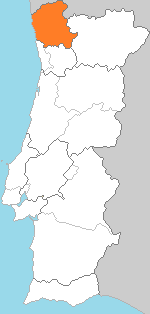The Leuni were an ancient Celtic tribe of Gallaecia, living in the north of modern Portugal, in the province of Minho, between the rivers Lima and Minho.
The Leuni were an ancient Celtic tribe of Gallaecia, living in the north of modern Portugal, in the province of Minho, between the rivers Lima and Minho.

The Bracari or Callaeci Bracari were an ancient Celtic tribe of Gallaecia, living in the northwest of modern Portugal, in the province of Minho, between the rivers Tâmega and Cávado. After the conquest of the region beginning in 136BC, the Romans established the Augustan citadel of Bracara, modern Braga, in 20 BC.

The Equaesi were an ancient Celtic tribe of Gallaecia, who lived in the north of modern Portugal, between the provinces of Minho and Trás-os-Montes, near the border of modern Galicia (Spain).
The Grovii or Gravii were an ancient Gallaeci tribe who inhabited the low valley of the Minho river, present day Portugal and Galicia (Spain), and also along the coast near the rivers "Avo", Celadus, Nebis and Limia, northern Portugal.
The Interamici or Interamnici were a pre-Roman people or tribe, one of the Gallaeci tribes, living between some areas of modern southern Galicia (Spain), and some areas of northern Trás-os-Montes, modern northeast Portugal. Their name means "Between Waters" because they lived between the southern banks of the Minius (Minho) and Sil rivers and the northern headwaters of the Laethes or Limia (Lima) and Tamica (Tâmega) rivers.
The Limici were an ancient Celtic tribe of Gallaecia, living in the swamps of the river Lima, in the border region between Minho (Portugal) and Galicia (Spain).
The Narbasi were an ancient Celtic tribe of Gallaecia, living in the province of Minho and nearby areas of modern Galicia (Spain).
The Nemetati were an ancient Celtic tribe of Gallaecia, living in the north of modern Portugal between the Cávado and Ave Rivers, in the province of Minho, north of the Douro.They lived near the valley of the Ave River and may have some link with inscriptions to the war god Cosus Nemedecus. The Citânia de Sanfins could be their main hill fort. Their ethnic name comes from the Celtic nemeton, a place belonging to the sacred site/grove, or more likely, place belonging to Nemetos.
The Seurbi were a pre-Roman group of tribes living in the north of modern Portugal, in the province of Minho, between the rivers Cávado and Lima.

The North Region or Northern Portugal is the most populous region in Portugal, ahead of Lisbon, and the third most extensive by area. The region has 3,576,205 inhabitants according to the 2017 census, and its area is 21,278 kilometres (13,222 mi) with a density of 173 inhabitants per square kilometre. It is one of five regions of Mainland Portugal. Its main population center is the urban area of Porto, with about one million inhabitants; it includes a larger political metropolitan region with 1.8 million, and an urban-metropolitan agglomeration with 2.99 million inhabitants, including Porto and neighboring cities, such as Braga, Guimarães and Póvoa de Varzim. The Commission of Regional Coordination of the North (CCDR-N) is the agency that coordinates environmental policies, land-use planning, cities and the overall development of this region, supporting local governments and associations.

Caminha is a municipality in the north-west of Portugal, 21 km north from Viana do Castelo, located in the Viana do Castelo District. The population in 2011 was 16,684, in an area of 136.52 km².

Entre Douro e Minho is one of the historical provinces of Portugal which encompassed the country's northern Atlantic seaboard between the Douro and Minho rivers. Contemporaries often referred to the province as simply "Minho". It was one of six provinces Portugal was commonly divided into from the early modern period until 1936, although these provinces were not recognized as official units of government.

Minho was a former province in Portugal, established in 1936 and dissolved in 1976. It consisted of 23 municipalities, with its capital in the city of Braga. Today, the area would include the districts of Braga and Viana do Castelo. Minho has substantial Celtic influences and shares many cultural traits with neighbouring Galicia in Northwestern Spain. The region was part of the Roman Province and early Germanic medieval Kingdom of Gallaecia. Historical remains of Celtic Minho include Briteiros Iron Age Hillfort, the largest Gallaecian native stronghold in the Entre Douro e Minho region, in North Portugal. The University of Minho, founded in 1973, takes its name from the former province.

Valença, also known as Valença do Minho, is a municipality and a town in Portugal. The population in 2011 was 14,127, in an area of 117.13 km2.

Chantada, is a municipality in the province of Lugo, Galicia, Spain.
Portus Cale was an ancient town and port in present-day northern Portugal, in the area of today's Porto and Vila Nova de Gaia. The name of the town eventually influenced the name of the subsequent country of Portugal, from the 9th century onwards.

The Citânia de Briteiros is an archaeological site of the Castro culture located in the Portuguese civil parish of Briteiros São Salvador e Briteiros Santa Leocádia in the municipality of Guimarães; important for its size, "urban" form and developed architecture, it is one of the more excavated sites in northwestern Iberian Peninsula. Although primarily known as the remains of an Iron Age proto-urban hill fort, the excavations at the site have revealed evidence of sequential settlement, extending from the Bronze to Middle Ages.

The Roman Thermae of Maximinus, are the archaeological ruins of a monumental building and public baths, whose construction was integrated into the urban renewal of the civitas of Bracara Augusta, the Roman provincial capital of Gallaecia. The large public/civic construction consisted of a building, housing the baths and a theatre, although the archaeological excavations continue.